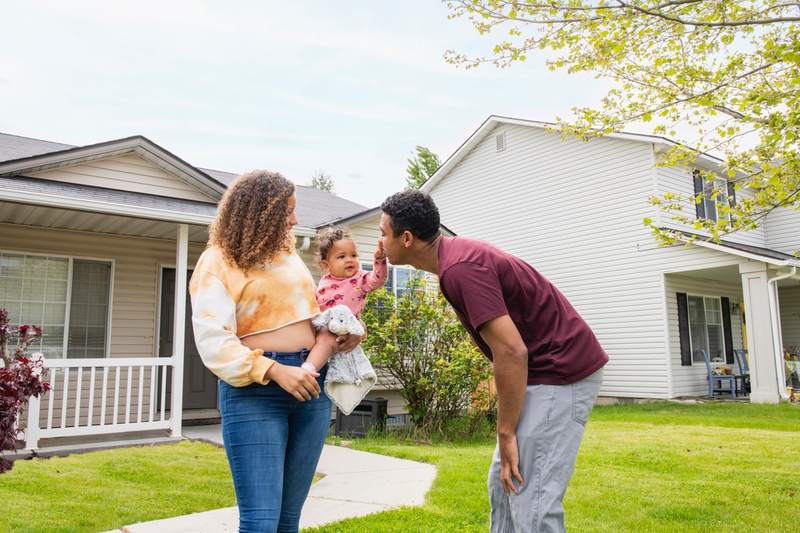When you buy a home, you’ll usually have to pay a long list of closing costs, which include fees to the lender. But what if you can’t afford closing costs, or you simply want to avoid them?
No-closing-cost mortgages may sound like the solution, but their name can be deceiving. While your upfront closing costs will be covered by your lender, you’ll pay for them eventually in the form of a higher mortgage interest rate or principal.
Key Takeaways:
- No-closing-cost mortgages work by allowing you to avoid upfront closing costs in exchange for a higher interest rate or principal.
- It’s important to consider the pros and cons of no-closing-cost mortgages.
- Before you buy a home with a no-closing-cost mortgage, consider alternatives to saving on mortgage closing costs.
What Is a No-Closing-Cost Mortgage?
A no-closing-cost mortgage is a home loan where closing costs are covered by the lender in exchange for a higher interest rate or principal. While you may still have to pay an application fee and third-party fees for appraisals and home inspections, the lender doesn’t tack on an added closing fee.
No-closing-cost mortgages can help buyers who don’t have enough cash to cover closing costs out of pocket, but significant increases to a loan’s interest rate could mean paying more in the long term.
“A no-closing-cost mortgage can be a good deal in some situations, but it’s important to look at more than just the closing costs,” says Michael Anderson, a certified financial planner and independent financial advisor at Maranatha Financial in Ventura, California.
Some no-closing-cost mortgages are advertised under different names. These names include:
- No-fee mortgage.
- Zero-closing-cost mortgage.
- No-cost mortgage.
- No-closing-fees mortgage.
- No-closing-cost home loan.
Regardless of the name, it’s important to understand the details to know exactly what you’re paying for.
What do closing costs include?
Closing costs are paid during the closing process. While you also may make a significant down payment and pay real estate agent commissions, those won’t be included in your estimated closing costs.
Average total closing costs are typically around 2% to 5% of the home’s purchase price. This means a $250,000 home requires approximately $5,000 to $12,500 in upfront closing costs.
It’s important to factor in all potential closing costs when picking a home and a mortgage to ensure you can afford the home in the long run. These are the most common closing costs you’ll likely encounter:
- Appraisal fees. Home appraisals are typically required by lenders to verify the home’s value, which determines how much they’ll lend to you.
- Tax service fees. Title insurance companies, banks, or other providers may take on several tax-related tasks for a fee. This includes verifying property taxes to ensure there are no tax liens on the home.
- Title insurance. Title insurance provides financial protection if you buy a home and someone files a lawsuit saying they have a legal claim against the home. You’re usually required to buy lenders title insurance, which protects lenders.
- Taxes. Most property sales require filing forms with local government offices — usually at a cost. If applicable, title or property change taxes could also be included.
- Prepaid expenses. Many lenders handle property taxes and homeowners insurance payments on behalf of the homeowner through an escrow account. This can also include any interest until your first payment is due.
How Do No-Closing-Cost Mortgages Work?
While there’s no fee paid at closing for mortgages with no closing costs, the lender is likely recouping the fee elsewhere. Two common methods of doing so are to finance the closing costs or to increase the mortgage interest rate.
When the closing costs are financed, the total mortgage amount increases by the fee amount. While this will cost you less upfront, your long-term costs will likely be higher when you finance closing costs.
Other lenders offer no-closing-cost mortgages by charging a slightly higher interest rate. For example, a bank might raise the interest rate by a fraction of a percentage point. While a difference of 0.02 or 0.05 percentage points may not seem like much, the interest can add up over 15 or 30 years.
“You should never sign up for a loan you can’t afford in the long term, regardless of closing costs,” Anderson says. “Getting the wrong loan can lead to trouble if you can’t keep up with the mortgage payments in the future.”
Who offers no-closing-cost mortgages?
If you’re shopping for a no-closing-cost mortgage, it’s a good idea to compare your interest rates and fees for multiple loans from different lenders. Doing so gives you more information to choose the most affordable options.
Some lenders offer no-closing-cost mortgages as a listed option, while others allow you to finance your closing costs, effectively giving you a mortgage with no closing costs. Many online mortgage lenders and banks offer a variation of no-closing-fee mortgages.
The True Cost of a No-Closing-Cost Mortgage
When comparing multiple loan options, knowing the true cost of a no-closing-cost can be challenging. The loan’s annual percentage rate, or APR, is a helpful tool to understand the annual cost of borrowing money.
Higher mortgage rates
Higher mortgage rates increase your monthly payment. With a higher rate, you’ll pay more per month for every dollar you borrow. A mortgage calculator can help you estimate your monthly payment at different interest rates.
Higher loan amount
Lenders can increase your loan amount to compensate for the upfront closing costs, which adds to your monthly payment. When lenders roll your closing costs into your mortgage, you might end up paying more in the long term than if you just paid the closing costs upfront.
No-closing-cost mortgage example
Here’s an example to help you better understand how to evaluate your loan options.
Let’s assume that someone is borrowing $250,000 with a 30-year fixed-rate mortgage. The lender offers a no-closing-cost option with an interest rate that’s higher by 0.05 percentage points. The higher interest rate would lead to a bigger payment every month, with a difference of $8.14. That’s almost $100 per year for 30 years, with the total cost coming to about $2,930.
If someone took this deal rather than pay $3,000 in closing costs, then they would come out ahead. If the closing costs are $2,500, then they would be paying more.
Pros and Cons of a No-Closing-Cost Mortgage
It’s important to know the benefits and drawbacks before taking out a no-closing-cost mortgage.
Pros of no-closing-cost mortgages
- Lower upfront costs when buying a home or refinancing.
- If you exchange upfront closing costs for a higher interest rate and you don’t plan on living in the home for long, you could save money.
- You can reallocate the savings from upfront closing costs to a larger down payment.
Cons of no-closing-cost mortgages
- The lender may add closing costs to the total loan amount.
- No-closing-cost mortgages often come with a higher interest rate.
- No-closing-cost mortgages can be deceiving if fees are paid in other ways.
Alternatives To Saving On Mortgage Closing Costs
If a no-closing-cost mortgage isn’t for you, or you’re looking for additional savings when buying a home or refinancing, consider these alternatives:
- First-time homebuyer grants. Some local, state, and federal government programs offer financial assistance for first-time homebuyers. The Department of Housing and Urban Development is a great resource to start your search for these programs.
- Government lending programs. Depending on your situation, you may qualify for various government-backed loans. Federal Housing Administration loans and Veterans Affairs loans offer a lower down payment and lower minimum credit score for qualified borrowers.
- Negotiate with the lender. The lender likely publishes a fee schedule, but you may be able to negotiate. “Negotiating with your lender can lead to big savings,” Anderson says. “You may be able to negotiate lower fees or even a lower interest rate.” The worst response you’ll get is a refusal, so it’s always worth trying.
- Shop for lower-cost providers. Shopping for a mortgage online can help you quickly assess your options based on your credit score and desired loan amount.
Should You Get a No-Closing-Cost Mortgage?
Everyone’s financial situation is different, so there’s no universal answer to whether a no-closing-cost mortgage is the right choice for you. The answer comes down to your borrowing options and preferences.
For most borrowers, the first step should be to figure out which is the most cost-effective option. If you’re struggling to get into a home, you may be willing to pay a little more to get a slice of real estate to call your own.
No-closing-cost mortgages may look like the best deal on the surface, but only by crunching the numbers will you find the most cost-effective option.
FAQ: No-Closing-Cost Mortgage
Here are answers to some frequently asked questions about no-closing-cost mortgages.
No-closing-cost mortgage is a term for a mortgage where the lender doesn’t charge any upfront closing fees. The loan may still incur other charges, however.
Any mortgage can be refinanced, assuming the lender approves your financial situation and property. You can refinance with a new no-closing-cost mortgage or a traditional mortgage.
Government loan programs are administered by retail lenders, like online mortgage companies. You can find no-closing-cost mortgage options by working directly with these companies.
The Bottom Line on No-Closing-Cost Mortgages
A no-closing-cost mortgage can be a great way for a buyer to reduce the upfront costs of purchasing a house and become a homeowner sooner, but it’s important to know that you’ll be paying for these costs in other ways. Comparing APRs and loan terms helps you understand the true cost of a loan so you can make the most informed borrowing decision.






